
Safety for Every Body in Occupant Protection
There’s almost 8 billion people in the world today. Is it reasonable to say that an awful lot of this population travel by motor vehicles of some type every single day? Of course, it is. And it’s always been abundantly clear too that we have an incredible diversity of human anthropometry spanning this globe that we must consider as they consistently put their faith in the safety of these vehicles. It’s not always about how many personal automobiles exist, but being an occupant in any type of motorized transportation comes with a certain level of risk.
Now, have you ever wondered how engineers and scientists design vehicles so that they are safe for different sizes, shapes, and types of people? It turns out this is more complex than a lot of folks realize. As mentioned, people come in different genders, ages, heights, weights and all types of body shapes and conditions. All of these things can be important in how safety is designed into a vehicle.
scientists design vehicles so that they are safe for different sizes, shapes, and types of people? It turns out this is more complex than a lot of folks realize. As mentioned, people come in different genders, ages, heights, weights and all types of body shapes and conditions. All of these things can be important in how safety is designed into a vehicle.
Engineers have been designing vehicles for different sizes of occupants for a long time, using various crash dummies and crash test types. Vehicles are safer than ever before, but injuries and fatalities remain a really big problem in our society, thus there is still much work to be done. Much of that upcoming work is related to expanding the design process to include types of people that were not specifically considered before. You might say we need to design vehicles not only for everybody but for Every Body!!!
Let’s start by peeking behind the curtain to see how vehicles are designed for safety…. What the process has been in the past, what new advanced tools are now available, and what might be required in the future to consider even more types of people.
First, we can’t forget that seatbelts are one of the most important safety features in any vehicle. In a crash, they help to keep occupants in their seats and distribute the force of the impact across their bodies, reducing the risk of injury.
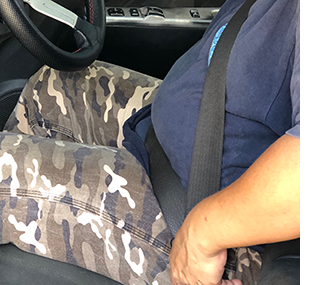 One of the main ways that body size can impact seatbelt fit is through the height of the occupant. Proper fit means the lap belt should sit snugly across your hips and the shoulder belt should across your chest, passing over your sternum. The seatbelt should be tight enough that you can only fit one or two fingers between your body and the seatbelt.
One of the main ways that body size can impact seatbelt fit is through the height of the occupant. Proper fit means the lap belt should sit snugly across your hips and the shoulder belt should across your chest, passing over your sternum. The seatbelt should be tight enough that you can only fit one or two fingers between your body and the seatbelt.
But taller individuals may find that the seatbelt is too low on their chest, which can increase the risk of injury in a crash. Similarly, shorter individuals may find that the seatbelt is too high on their chest. Both of these can result in less than ideal restraint.
What about the overall size of an individual? A startling new report from the World Obesity Federation's 2023 atlas predicts that more than half of the world will be overweight or obese by 2035. So back to the seatbelt fit paradigm, with larger and obese individuals, the seatbelt may not fit properly, which can increase the risk of injury in a crash. An improperly fitting seatbelt can also cause discomfort, leading to the occupant adjusting the seatbelt or not wearing it at all.
Let’s also point out that the position of your actual seat can also impact your safety in a crash. When you're sitting in a vehicle, you should be able to reach the pedals and the steering wheel without stretching, and your back should be supported by the seatback. If your seat is too far back, again, your seatbelt may not fit properly, which can increase the risk of injury in a crash.
A startling new report from the World Obesity Federation's 2023 atlas predicts that more than half of the world will be overweight or obese by 2035.
Next up are the airbag requirements on all passenger vehicles sold in the US, Europe, and many other parts of the world. Designed to protect occupants of average size, larger or smaller individuals may not get the intended protection.
How do we determine the occupant sizes we use when designing crash test dummies?
Modern crash test dummies are typically produced around the percentile system referring to the size of the dummy relative to the population of humans. It’s commonly used to describe the size of people, and it is based on a range of body dimensions such as overall height, sitting height and weight. The system divides the population into 100 equal parts or percentiles, so that the 50th percentile represents the median size for a particular population.
For example, if a crash test dummy is described as a "50th percentile” male," it means that the dummy represents a size larger than 50% of the adult male population and smaller than 50% of that population. Similarly, a "95th percentile male" dummy would represent a male in the 95th percentile for body dimensions, which means that he is larger than 95% of males in the population. Percentile descriptions are one measure used to help ensure that dummies in crash testing are representative of the population and provide relevant data on crash performance.
There are several downsides to using only the 5th, 50th, and 95th percentiles in crash testing to characterize the entire human population.
Today, there are two prominent percentiles that are used by the crash test industry to evaluate occupant safety – the 5th, and 50th, and then there is a limited presence of the 95th. The thought is that the middle ground with the extremes could be the best generality to cover a wide swath of the human population.
To be fair, this is a logical strategy to try to optimize crash testing programs and theoretically get a decent amount of data to represent the entirety of the masses. But there are several downsides to using only the 5th, 50th, and 95th percentiles in crash testing to characterize the entire human population.
Limited representation from just concentrating on the 5th, 50th, and 95th percentiles may not completely reflect the range of body types, sizes, and shapes that really exist. As a result, crash testing based on these percentiles may not accurately reflect the impact of a crash on a broader range of individuals.
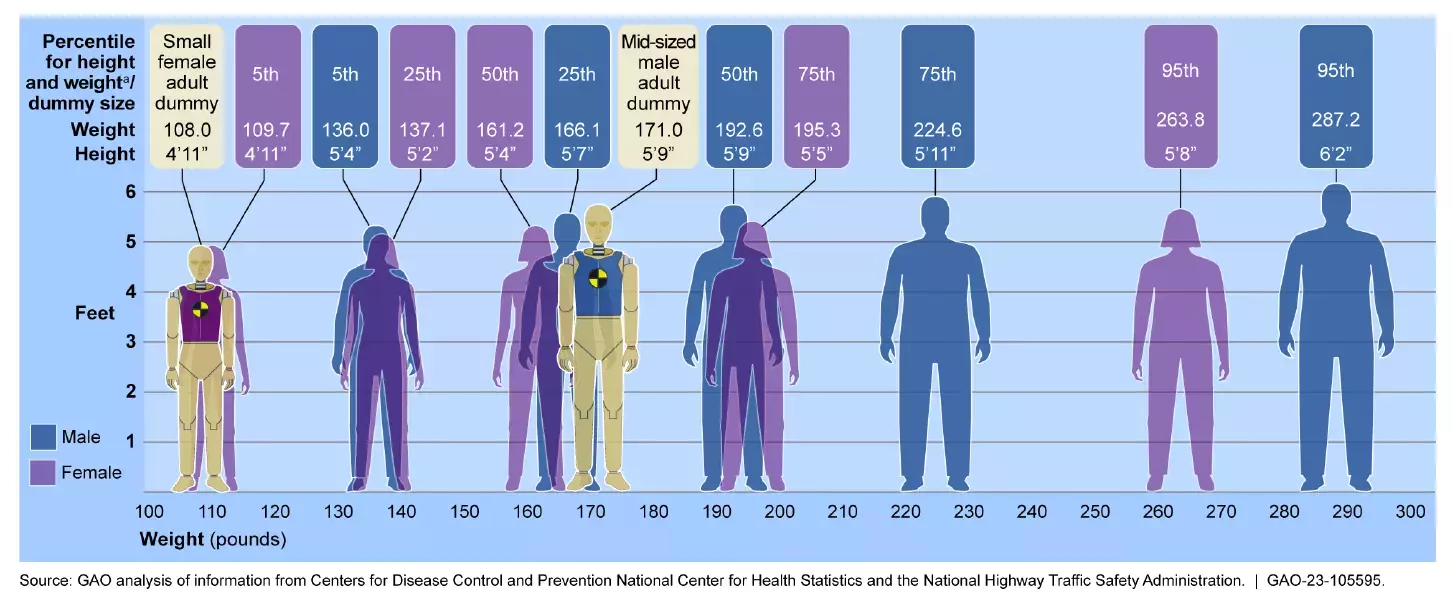
There’s also the danger of ignoring vulnerable populations such as the elderly, obese, and those with disabilities. These populations may have different physiological and biomechanical responses to crashes and may require different safety features and testing protocols.
Testing with only a few percentile sized dummies may not provide a complete picture of the variability in the population. By relying solely on these few sizes, crash testing may miss important variations and outliers that could impact the safety of the general population.
Overall, while using the 5th, 50th, and 95th percentiles in crash testing is a useful tool for evaluating vehicle safety, maybe it should not be relied upon as the sole method for representing the entire human population. Additional testing and consideration of vulnerable populations and real-world scenarios may be necessary to ensure the safety of all individuals.
…most restraint systems are designed around mid-sized and smaller occupants using 1970’s anthropometric data…
Does a person’s age make a difference in occupant safety?
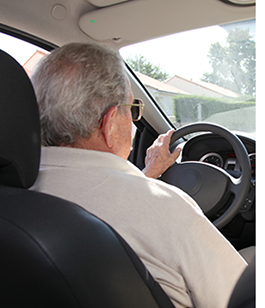 A person's age can invariably make a difference in occupant safety. Different age groups have varying physical capabilities and vulnerabilities that can affect how well they can withstand or recover from a crash.
A person's age can invariably make a difference in occupant safety. Different age groups have varying physical capabilities and vulnerabilities that can affect how well they can withstand or recover from a crash.
We all know infants and young children are particularly vulnerable in car crashes due to their smaller size and underdeveloped bodies. They require special restraints such as car seats or booster seats to protect them from injury. That’s why we have a family of child test dummies to help sort out the best way to provide them the critical protection they need.
But older adults also have specific vulnerabilities in car crashes. They may have weaker bones, reduced muscle mass, and slower reflexes, which can increase their risk of injury in a crash.
In addition to physical vulnerabilities, age can also impact cognitive and sensory abilities, which can affect a person's ability to react to potential dangers on the road. For example, older adults may have decreased vision, hearing, and reaction time, which can increase their risk of being involved in a crash.
What do we do to ensure a broader representation of bodies in crash testing?
Certainly, we need additional research and data to finely tune the way we measure a wider range of body sizes and the effectiveness of our occupant safety measures in today’s vehicle designs. To that end, we do have tools available today that can help researchers learn more about the best way to protect everyone when the unthinkable crash occurs. We have an Obese crash test dummy that has a body mass that nearly 300 lbs. (123.82 kg), representing a Body Mass Index (BMI) of 35. Since most restraint systems are designed around mid-sized and smaller occupants using 1970’s anthropometric data, the Obese ATD features additional size and mass to better represent larger vehicle occupants.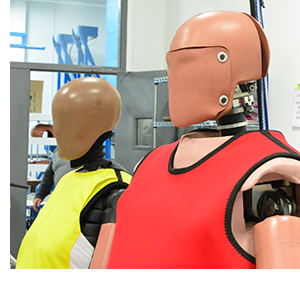
Also included in the fleet of physical R&D crash test dummies is the Elderly crash dummy representing a 70-year-old female occupant with a height of 161 cm and a BMI of 29. With anthropometry developed in part by utilizing actual crash injury research from the International Center for Automotive Medicine (ICAM) and the University of Michigan Transportation Research Institute (UMTRI), the Elderly dummy features an external body shape designed with precise internal organ positioning aided using MRI scan data and a revolutionary new organ impact measurement system. This design allows for precise regional stiffness differences and pressure measurements of internal injuries sustained in potential automotive accidents for this rapidly growing demographic.
And lest we forget about the female body sizes mentioned in the previous article represented by the new, advanced THOR-5F to help us round out some of these types of underrepresented vehicle occupants.
Can virtual testing help fill in the gaps?
Virtual crash testing, also known as computer simulation, is a process in which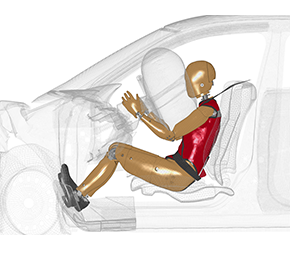 computer models of vehicles and crash test dummies are used to simulate a crash. It’s a cost-effective and efficient way to test the safety of vehicles and evaluate the crashworthiness of various components, such as the vehicle's structure, airbags, and seat belts, and to assess the injury risk to occupants in various crash scenarios. Virtual testing can help calculate safety effectiveness in the earlier stages of design before physical validation occurs.
computer models of vehicles and crash test dummies are used to simulate a crash. It’s a cost-effective and efficient way to test the safety of vehicles and evaluate the crashworthiness of various components, such as the vehicle's structure, airbags, and seat belts, and to assess the injury risk to occupants in various crash scenarios. Virtual testing can help calculate safety effectiveness in the earlier stages of design before physical validation occurs.
By using virtual crash testing, researchers and engineers can simulate a wide range of crash scenarios, including those that may not be feasible or safe to test using physical crash test dummies. And also notably, they can use virtual versions of body sizes that don’t yet exist in the physical test dummy world. This combination of crash parameters can be modified relatively easily to evaluate different safety features, such as changes to the vehicle structure or restraint systems.
The crucial premise that test engineers must use a wider range of body sizes for more accurate crash testing continues to be a topic of discussion. Crash testing is an essential part of the development process for vehicles and other transportation equipment. And since the purpose of crash testing is to ensure vehicles provide sufficient protection to the occupants in the event of a crash, it is important to use a range of body sizes because, well, people come in all shapes and sizes. Using only one size or a narrow range of sizes in crash testing may not always provide the extensive or accurate results we need to continue the advancement of vehicle safety.

Learn how newer advanced crash test dummies can help Raise The Bar For Injury Prevention

Mark Brown
Mark is the Product Marketing Manager at Humanetics Safety and works closely with Engineering and Sales to develop and refine content that is both useful and informative for our industry. With over two decades of experience in crash test dummy product Quality, Technical, Sales, and Marketing, Mark produces a wide range of media and publications including our service bulletins, webinars, editorial articles, and contributes to our marketing collateral.